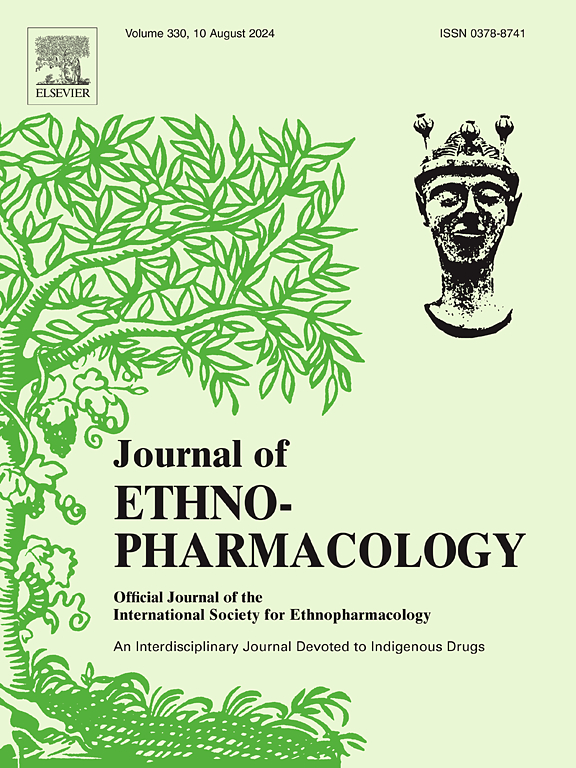Shizhifang alleviates hyperuricemia -induced renal injury by inhibiting Drp1 and maintaining mitochondrial homeostasis in renal tubular epithelial cells
IF 5.4
2区 医学
Q1 CHEMISTRY, MEDICINAL
引用次数: 0
Abstract
Ethnopharmacological relevance
Shizhifang (SZF), a traditional Chinese herbal formula used at Shanghai Shuguang Hospital for over 20 years, has shown clinical efficacy in lowering serum uric acid (SUA) and protecting renal function.
Aim of the study
To explore the mechanism by which SZF protects against hyperuricemia (HUA)-induced renal tubular epithelial cell injury, focusing on mitochondrial dysfunction mediated by Drp1.
Materials and methods
RNA-seq was performed on HK2 cells to identify affected pathways. HUA rat and mouse models were used to assess renal function, oxidative stress, inflammation, and mitophagy. Key interventions included SZF, a Drp1 inhibitor, and autophagy modulators. In vitro, Drp1 knockdown HK2 cells were used to evaluate ROS, mitochondrial membrane potential (MMP), and proteins involved in mitochondrial dynamics and mitophagy.
Results
SZF significantly reduced SUA, improved renal function, suppressed ROS and inflammation, and alleviated mitochondrial damage. RNA-seq revealed enrichment of ROS and mitophagy pathways. SZF and Drp1 inhibition restored MMP, reduced fission and mitophagy, and enhanced mitochondrial fusion. Combined SZF and Drp1 siRNA treatment showed superior efficacy.
Conclusions
SZF mitigates HUA-induced renal injury by inhibiting Drp1-mediated mitochondrial fission and mitophagy, promoting mitochondrial fusion, and reducing oxidative stress. These findings reveal a novel mitochondrial mechanism for SZF's reno-protective effect.

石栀方通过抑制Drp1,维持肾小管上皮细胞线粒体稳态,减轻高尿酸血症所致的肾损伤
中药史止方是上海曙光医院使用20多年的传统中药配方,具有降低血尿酸、保护肾功能的临床疗效。目的探讨SZF对高尿酸血症(HUA)诱导的肾小管上皮细胞损伤的保护机制,重点探讨Drp1介导的线粒体功能障碍。材料和方法对HK2细胞进行srna -seq鉴定受影响的通路。HUA大鼠和小鼠模型用于评估肾功能、氧化应激、炎症和线粒体自噬。关键干预措施包括SZF,一种Drp1抑制剂和自噬调节剂。在体外,使用Drp1敲低HK2细胞来评估ROS、线粒体膜电位(MMP)以及参与线粒体动力学和线粒体自噬的蛋白质。结果ssszf显著降低SUA,改善肾功能,抑制ROS和炎症,减轻线粒体损伤。RNA-seq显示ROS和线粒体自噬途径的富集。抑制SZF和Drp1恢复MMP,减少分裂和线粒体自噬,增强线粒体融合。SZF联合Drp1 siRNA治疗效果更佳。结论sszf可抑制drp1介导的线粒体分裂和线粒体自噬,促进线粒体融合,降低氧化应激,减轻hua所致肾损伤。这些发现揭示了SZF对肾保护作用的一种新的线粒体机制。
本文章由计算机程序翻译,如有差异,请以英文原文为准。
求助全文
约1分钟内获得全文
求助全文
来源期刊

Journal of ethnopharmacology
医学-全科医学与补充医学
CiteScore
10.30
自引率
5.60%
发文量
967
审稿时长
77 days
期刊介绍:
The Journal of Ethnopharmacology is dedicated to the exchange of information and understandings about people''s use of plants, fungi, animals, microorganisms and minerals and their biological and pharmacological effects based on the principles established through international conventions. Early people confronted with illness and disease, discovered a wealth of useful therapeutic agents in the plant and animal kingdoms. The empirical knowledge of these medicinal substances and their toxic potential was passed on by oral tradition and sometimes recorded in herbals and other texts on materia medica. Many valuable drugs of today (e.g., atropine, ephedrine, tubocurarine, digoxin, reserpine) came into use through the study of indigenous remedies. Chemists continue to use plant-derived drugs (e.g., morphine, taxol, physostigmine, quinidine, emetine) as prototypes in their attempts to develop more effective and less toxic medicinals.
 求助内容:
求助内容: 应助结果提醒方式:
应助结果提醒方式:


